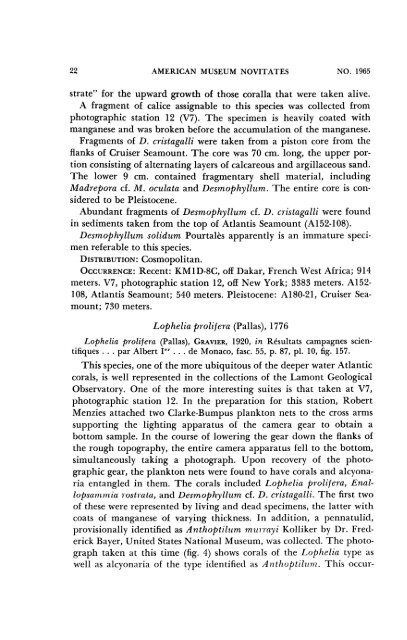MXieuicanJAuscum - American Museum of Natural History
MXieuicanJAuscum - American Museum of Natural History
MXieuicanJAuscum - American Museum of Natural History
You also want an ePaper? Increase the reach of your titles
YUMPU automatically turns print PDFs into web optimized ePapers that Google loves.
22 AMERICAN MUSEUM NOVITATES NO . 1 965<br />
strate" for the upward growth <strong>of</strong> those coralla that were taken alive.<br />
A fragment <strong>of</strong> calice assignable to this species was collected from<br />
photographic station 12 (V7). The specimen is heavily coated with<br />
manganese and was broken before the accumulation <strong>of</strong> the manganese.<br />
Fragments <strong>of</strong> D. cristagalli were taken from a piston core from the<br />
flanks <strong>of</strong> Cruiser Seamount. The core was 70 cm. long, the upper portion<br />
consisting <strong>of</strong> alternating layers <strong>of</strong> calcareous and argillaceous sand.<br />
The lower 9 cm. contained fragmentary shell material, including<br />
Madrepora cf. M. oculata and Desmophyllum. The entire core is considered<br />
to be Pleistocene.<br />
Abundant fragments <strong>of</strong> Desmophyllum cf. D. cristagalli were found<br />
in sediments taken from the top <strong>of</strong> Atlantis Seamount (A152-108).<br />
Desmophyllum solidum Pourtal'es apparently is an immature specimen<br />
referable to this species.<br />
DISTRIBUTION: Cosmopolitan.<br />
OCCURRENCE: Recent: KMlD-8C, <strong>of</strong>f Dakar, French West Africa; 914<br />
meters. V7, photogr-aphic station 12, <strong>of</strong>f New York; 3383 meters. A152-<br />
108, Atlantis Seamount; 540 meters. Pleistocene: A180-21, Cruiser Seamount;<br />
730 meters.<br />
Lophelia prolifera (Pallas), 1776<br />
Lophelia prolifera (Pallas), GRAVIER, 1920, in R6sultats campagnes scientifiques<br />
... par Albert ler ... de Monaco, fasc. 55, p. 87, pl. 10, fig. 157.<br />
This species, one <strong>of</strong> the more ubiquitous <strong>of</strong> the deeper water Atlantic<br />
corals, is well represented in the collections <strong>of</strong> the Lamont Geological<br />
Observatory. One <strong>of</strong> the more interesting suites is that taken at V7,<br />
photographic station 12. In the preparation for this station, Robert<br />
Menzies attached two Clarke-Bumpus plankton nets to the cross arms<br />
supporting the lighting apparatus <strong>of</strong> the camera gear to obtain a<br />
bottom sample. In the course <strong>of</strong> lowering the gear down the flanks <strong>of</strong><br />
the rough topography, the entire camera apparatus fell to the bottom,<br />
simultaneously taking a photograph. Upon recovery <strong>of</strong> the photographic<br />
gear, the plankton nets were found to have corals and alcyonaria<br />
entangled in them. The corals included Lophelia prolifera, Enallopsanimia<br />
rostrata, and Desmophyllum cf. D. cristagalli. The first two<br />
<strong>of</strong> these were represented by living and dead specimens, the latter with<br />
coats <strong>of</strong> manganese <strong>of</strong> varying thickness. In addition, a pennatulid,<br />
provisionally identified as Anthoptiltum murrayi Kolliker by Dr. Frederick<br />
Bayer, United States National <strong>Museum</strong>, was collected. The photograph<br />
taken at this time (fig. 4) shows corals <strong>of</strong> the Lophelia type as<br />
well as alcyonaria <strong>of</strong> the type identifie(d as Anthoptilbin. This occur-
















